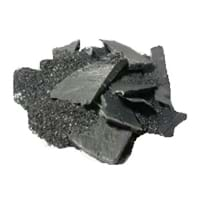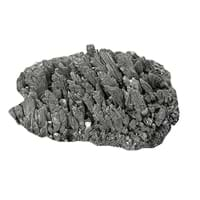Thorium vs Magnesium
Periodic Table
Symbol
Th
Mg
Group Number
0
18
2
16
Period Number
7
3
Block
f block
s block
Element Family
Actinide
Alkaline Earth
CAS Number
7440326
99+
7439954
99+
Space Group Name
P63/mmc
P63/mmc
Space Group Number
194.00
5
194.00
5
Facts
Interesting Facts
- Thorium metal is used as an alternate option over Uranium for nuclear fuel.
- Thorium metals appearance (silvery white, soft) is somewhat similar to Lead metal.
- Magnesium ions are present in every chlorophyll of every green plant .
- Controlling Magnesium fire by pouring water on it will result in explosions.
Sources
Found in Minerals, Mining
By Electrolysis Process, In Ocean, Mining
History
Who Discovered
Jöns Jakob Berzelius
Joseph Black
Discovery
In 1829
In 1755
Abundance
Abundance In Universe
3 * 10-4 %
9
6 * 10-2 %
2
Abundance In Sun
~0.0004 %
9
~0.07 %
2
Abundance In Meteorites
0.05 %
11
12.00 %
2
Abundance In Earth's Crust
0.66 %
7
2.90 %
4
Abundance In Oceans
0.00 %
15
0.13 %
2
Abundance In Humans
Not Available
0.03 %
4
Uses
Uses & Benefits
- Thorium metal is used as an allying agent for Magnesium, It imparts greater strength and resistance to temperature.
- compound of this metal Thorium oxide is used as an industrial catalyst.
- Magnesium aluminum alloy improves the mechanical strength and welding characteristics and hence it is used in aeroplane and car manufacturing.
- It is also used to remove sulfur from the molten iron and steel.
Industrial Uses
Aerospace Industry, Automobile Industry, Chemical Industry, Electrical Industry, Electronic Industry
Aerospace Industry, Ammunition Industry, Automobile Industry, Chemical Industry, Pharmaceutical Industry
Medical Uses
Dentistry, Surgical Instruments Manufacturing
NA
Other Uses
Alloys, Jewellery, Sculptures, Statues
Surgical Instruments Manufacturing
Biological Properties
Toxicity
Non Toxic
Non Toxic
Present in Human Body
Yes
Yes
In Blood
0.00 Blood/mg dm-3
33
37.80 Blood/mg dm-3
5
In Bone
0.02 p.p.m.
29
1,800.00 p.p.m.
4
Physical Properties
Melting Point
1,750.00 °C
17
650.00 °C
99+
Boiling Point
4,790.00 °C
8
1,107.00 °C
99+
Appearance
Physical State
Solid
Solid
Color
Silver
Gray
Luster
NA
NA
Hardness
Mohs Hardness
3.00
12
2.50
14
Brinell Hardness
390.00 MPa
29
260.00 MPa
36
Vickers Hardness
295.00 MPa
29
Not Available
Speed of Sound
2,490.00 m/s
36
4,940.00 m/s
11
Optical Properties
Reflectivity
Not Available
74.00 %
7
Allotropes
No
No
α Allotropes
Not Available
Not Available
β Allotropes
Not Available
Not Available
γ Allotropes
Not Available
Not Available
Chemical Properties
Chemical Formula
Th
Mg
Isotopes
Known Isotopes
28
11
15
24
Electronegativity
Pauling Electronegativity
1.30
32
1.31
31
Sanderson Electronegativity
Not Available
1.32
18
Allred Rochow Electronegativity
1.11
29
1.23
25
Mulliken-Jaffe Electronegativity
Not Available
1.37
16
Allen Electronegativity
Not Available
1.29
35
Electropositivity
Pauling Electropositivity
2.70
22
2.69
23
Ionization Energies
1st Energy Level
587.00 kJ/mol
99+
737.70 kJ/mol
24
2nd Energy Level
1,110.00 kJ/mol
99+
1,450.70 kJ/mol
99+
3rd Energy Level
1,978.00 kJ/mol
99+
7,732.70 kJ/mol
5
4th Energy Level
2,780.00 kJ/mol
99+
10,542.50 kJ/mol
4
5th Energy Level
Not Available
13,630.00 kJ/mol
3
6th Energy Level
Not Available
18,020.00 kJ/mol
3
7th Energy level
Not Available
21,711.00 kJ/mol
3
8th Energy Level
Not Available
25,661.00 kJ/mol
3
9th Energy Level
Not Available
31,653.00 kJ/mol
3
10th Energy Level
Not Available
35,458.00 kJ/mol
5
11th Energy Level
Not Available
169,988.00 kJ/mol
1
12th Energy Level
Not Available
189,368.00 kJ/mol
1
Electrochemical Equivalent
2.16 g/amp-hr
24
0.45 g/amp-hr
99+
Electron Work Function
3.41 eV
32
3.66 eV
29
Other Chemical Properties
Corrosion, Ionization, Radioactive Isotopes, Radioactivity
Corrosion, Highly Inflammable, Ionization, Solubility
Atomic Properties
Atomic Number
90
28
12
99+
Electron Configuration
[Rn] 6d2 7s2
[Ne] 3s2
Crystal Structure
Face Centered Cubic (FCC)
Hexagonal Close Packed (HCP)
Crystal Lattice
FCC-Crystal-Structure-of-Thorium.jpg#100
HCP-Crystal-Structure-of-Magnesium.jpg#100
Atom
Number of Protons
90
28
12
99+
Number of Neutrons
142
15
12
99+
Number of Electrons
90
28
12
99+
Radius of an Atom
Atomic Radius
179.80 pm
15
160.00 pm
27
Covalent Radius
206.00 pm
7
141.00 pm
99+
Van der Waals Radius
237.00 pm
15
173.00 pm
37
Atomic Weight
232.04 amu
23
24.31 amu
99+
Atomic Volume
19.90 cm3/mol
20
13.97 cm3/mol
37
Adjacent Atomic Numbers
Valence Electron Potential
59.30 (-eV)
23
40.00 (-eV)
99+
Lattice Constant
508.42 pm
14
320.94 pm
99+
Lattice Angles
π/2, π/2, π/2
π/2, π/2, 2 π/3
Lattice C/A Ratio
Not Available
Not Available
Mechanical Properties
Density
Density At Room Temperature
11.72 g/cm3
32
1.74 g/cm3
99+
Density When Liquid (at m.p.)
Not Available
1.58 g/cm3
99+
Tensile Strength
Not Available
Not Available
Viscosity
Not Available
Not Available
Vapor Pressure
Vapor Pressure at 2000 K
0.00 (Pa)
22
Not Available
Elasticity properties
Shear Modulus
31.00 GPa
21
17.00 GPa
37
Bulk Modulus
54.00 GPa
22
45.00 GPa
25
Young's Modulus
79.00 GPa
24
45.00 GPa
39
Poisson Ratio
0.27
20
0.29
15
Other Mechanical Properties
Ductile
NA
Magnetic Properties
Magnetic Characteristics
Specific Gravity
11.70
23
1.74
99+
Magnetic Ordering
Paramagnetic
Paramagnetic
Electrical Properties
Electrical Property
Superconductor
Conductor
Resistivity
157.00 nΩ·m
22
43.90 nΩ·m
99+
Electrical Conductivity
0.07 106/cm Ω
31
0.23 106/cm Ω
7
Electron Affinity
Not Available
0.00 kJ/mol
40
Thermal Properties
Specific Heat
0.12 J/(kg K)
40
1.02 J/(kg K)
4
Molar Heat Capacity
26.23 J/mol·K
30
24.87 J/mol·K
99+
Thermal Conductivity
54.00 W/m·K
28
156.00 W/m·K
8
Critical Temperature
Not Available
Not Available
Thermal Expansion
11.00 µm/(m·K)
36
24.80 µm/(m·K)
15
Enthalpy
Enthalpy of Vaporization
429.00 kJ/mol
15
128.70 kJ/mol
99+
Enthalpy of Fusion
15.48 kJ/mol
19
8.95 kJ/mol
39
Enthalpy of Atomization
468.60 kJ/mol
15
148.50 kJ/mol
99+
Standard Molar Entropy
27.30 J/mol.K
99+
32.70 J/mol.K
99+
|
||
|
||
|












